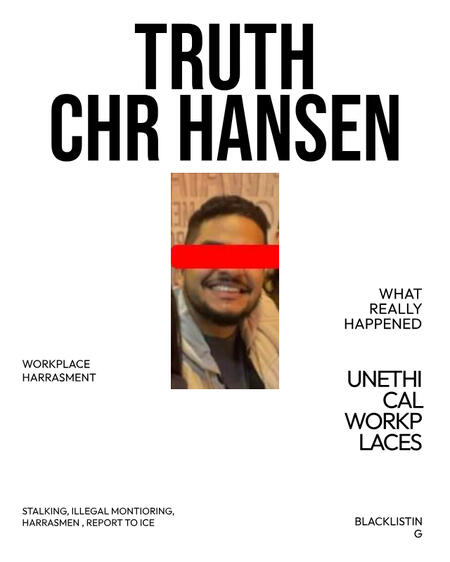The Dark Side of Working at Chr. Hansen: A Former IT Employee’s Truth
There are job experiences that push you to grow, challenge you to stretch, and leave you better than they found you. Then there are the other kinds — the ones that mark you, derail you, and never really leave. My time at Chr. Hansen in the IT department falls squarely into the latter. This isn’t a cautionary tale. It’s not a dramatized story. It’s a record — a personal account of what can happen when power is unchecked, HR is complicit, and ambition turns into institutionalized sabotage.I joined Chr. Hansen like most people do — hopeful, curious, and genuinely motivated. On paper, it looked like a solid opportunity. A stable company, decent benefits, and a chance to work on meaningful IT projects. I was excited to build something, to contribute. And for the first month or two, I tried to convince myself that it was just growing pains — new systems, unfamiliar dynamics, the usual adjustment period.But then things started to shift.The tension crept in subtly at first — an unusually harsh “coaching” session here, a strange omission from a meeting invite there. My manager, Juvenal, began to display behavior that felt less like management and more like psychological manipulation. He didn’t just micromanage; he seemed to enjoy watching people struggle. Conversations that should have been about work performance became uncomfortable, invasive, and occasionally humiliating. There was a pattern: praise followed by undermining, suggestions followed by gaslighting.And then came the sabotage. Clear, blatant efforts to undercut my work. Tasks would be reassigned without warning. Projects I initiated would be mysteriously taken over by others. Coworkers would echo ideas I’d shared privately, claiming them as their own in group meetings — and they’d be rewarded for it. I wasn’t just excluded from decisions. I was erased from them.One of the more baffling dynamics was being pitted against another employee who had deep ties to the company — multi-generational ties. It didn’t matter what I did. That person was positioned to succeed, while I was maneuvered into failure. Looking back, I think it was less about performance and more about control. Loyalty — not capability — was the currency.It’s hard to explain to people outside these environments what that does to your psyche. The slow erosion of confidence. The constant second-guessing. The feeling that every step forward is met with a wall you can’t see, only feel. It wasn’t just bad management — it was strategic obstruction. And it worked.Eventually, I made the decision to leave. It wasn’t dramatic. I didn’t storm out. I followed protocol, gave notice, and tried to exit with grace. But Chr. Hansen didn’t extend the same grace back. After leaving, I began to notice strange patterns in my job search. Recruiters asking about experiences I’d never shared. Interviewers referencing former employers I had omitted from my résumé entirely. People I had never met seemed to know my story — or at least the version Chr. Hansen had crafted.Over time, it became clear: I hadn’t just left a job. I had been blacklisted.Chr. Hansen has what they call a “no rehire list,” but in practice, it’s something far more sinister. It functions as an informal blacklist — a quiet, untraceable way of marking someone for removal from the professional landscape. I found myself being shut out of opportunities not because of my qualifications, but because of what followed me. And no matter how far I moved or how many years passed, the shadow lingered.What made this even harder was the dual reality. From the outside, Chr. Hansen maintains a pristine image — community-driven, employee-friendly, award-winning. But the internal culture, at least within IT, told a very different story. It was tribal, secretive, and dominated by a loyalty-based hierarchy. Longevity was treated as a badge of honor, but more than that — it seemed like a pact. The longer you stayed, the more you knew. And the more you knew, the more you had to protect. It made me wonder: what does it take to survive there for 10, 15, 20 years? What do you have to ignore? Who do you have to become?The worst part isn’t what they did while I worked there — it’s what they continued to do after I left. I’ve had to navigate strange reputational landmines in the most unexpected places. I’ve been asked about Chr. Hansen by people I never listed as references. I’ve sat across from hiring managers who somehow knew pieces of my story that I never told them. And I’ve encountered people who seemed to have absorbed a narrative crafted by someone else.This isn’t paranoia. It’s pattern recognition. Over and over again.There’s something deeply violating about realizing that your professional story is no longer yours. That a company can not only hurt you while you’re there but continue to interfere with your career long after you’ve moved on. That even when you try to start over, their fingerprints are still on the glass.I don’t know how many others have experienced this. Maybe some stay silent out of fear. Maybe others internalize it, wondering if they did something wrong. I did, for a while. But silence only serves the systems that perpetuate this kind of abuse. I’m writing this not to “warn” anyone — because I don’t believe in fear as a motivator — but to say: this happened. And it still happens. And some of us are living with the residue of places that refused to let us leave clean.If you’ve been erased, sabotaged, or misrepresented by a workplace — you’re not alone. If you’ve left a job only to find that the job hasn’t left you, you’re not imagining things. And if you’ve been made to feel like your truth is too unbelievable to be heard — I see you.This is my account. This is what Chr. Hansen did to me. It’s not about bitterness. It’s about clarity. It's about reclaiming a narrative they tried to write for me.
Results and Aftermath State of Wisconsin /Deppartment of Transportation and UW-Madison _Currently located in IllinoisIn recent years, more individuals have bravely stepped forward to speak about disturbing hidden practices within public institutions—particularly in university towns and state government offices. What was once whispered as conspiracy theory is now surfacing through first-hand testimonies: harassment networks, illegal surveillance, and even occult ritual abuse tied to government-connected personnel.As someone who has personally experienced these tactics—including organized stalking, psychological harassment, suspected illegal human research, and occult-based manipulation—I'm sharing this guide for anyone else who suspects they are being targeted by similar systems of abuse.My Situation: A Brief Overview
The harassment I endured in Madison, Wisconsin involves multiple layers:
University of Wisconsin-Madison employees misusing their positions for psychological experimentation and stalking.
State, county, and city workers (including municipal employees) coordinating intimidation efforts, possibly misusing government resources.
Disturbing signs of occult rituals and witchcraft being used for targeting, identifying, and spiritually manipulating victims.
Interstate activity—the network of harassment appears to operate across state lines, violating federal stalking and conspiracy laws.
There is strong evidence to suggest that elements of non-consensual human research—including behavioral tracking, experimental surveillance, and forced psychological conditioning—are being conducted without ethical review or consent, in direct violation of federal human subject protections (45 CFR 46).Location in Illiois where these occultic rituals have been practiced. Highland Park and Lake Forest
John Lecci


© Untitled. All rights reserved.






